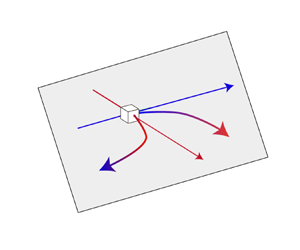Article contents
Dual-stage radial–tangential vortex tilting reverses radial vorticity and contributes to leading-edge vortex stability on revolving wings
Published online by Cambridge University Press: 19 May 2023
Abstract

The physics of leading-edge vortex (LEV) stability on flapping wings and autorotating seeds is still underexplored due to its complex dependency on Reynolds number ( $\textit {Re}$), aspect ratio (AR) and Rossby number (Ro). Our previous study observed an interesting dual-stage vortex tilting between radial and tangential components in a stable LEV. Here, the establishment of this novel mechanism, i.e. dual-stage radial–tangential vortex tilting (DS-VT
$\textit {Re}$), aspect ratio (AR) and Rossby number (Ro). Our previous study observed an interesting dual-stage vortex tilting between radial and tangential components in a stable LEV. Here, the establishment of this novel mechanism, i.e. dual-stage radial–tangential vortex tilting (DS-VT $_{r-t}$), is investigated and explained in detail using numerical methods. The contributions of other tangential vorticity transport terms are also considered. It is shown that the stable LEV region coincides mostly with a constant ratio of tangential and radial vorticity components. The DS-VT
$_{r-t}$), is investigated and explained in detail using numerical methods. The contributions of other tangential vorticity transport terms are also considered. It is shown that the stable LEV region coincides mostly with a constant ratio of tangential and radial vorticity components. The DS-VT $_{r-t}$ mechanism functions as a negative feedback loop for radial vorticity, thereby contributing to the LEV stability at
$_{r-t}$ mechanism functions as a negative feedback loop for radial vorticity, thereby contributing to the LEV stability at  $\textit {Re} > 500$. Specifically, this mechanism involves a dual-stage vortex tilting starting from negative radial component to positive tangential component, and then back to positive radial component, thereby leading to a
$\textit {Re} > 500$. Specifically, this mechanism involves a dual-stage vortex tilting starting from negative radial component to positive tangential component, and then back to positive radial component, thereby leading to a  $180^{\circ }$ reversal of radial vorticity. The radial Coriolis acceleration can also assist the DS-VT
$180^{\circ }$ reversal of radial vorticity. The radial Coriolis acceleration can also assist the DS-VT $_{r-t}$ by enhancing the tangential vorticity component and the reduction of radial vorticity inside the LEV via the second stage of DS-VT
$_{r-t}$ by enhancing the tangential vorticity component and the reduction of radial vorticity inside the LEV via the second stage of DS-VT $_{r-t}$. The effects of
$_{r-t}$. The effects of  $\textit {Re}$, AR and Ro on the constant radial–tangential vorticity ratio and DS-VT
$\textit {Re}$, AR and Ro on the constant radial–tangential vorticity ratio and DS-VT $_{r-t}$ are then analysed. The coupled effects of AR and Ro are separated into rotational effects and those of tip and root vortices. Our results establish an evident relationship among the LEV stability, the constant radial–tangential vorticity ratio, and the DS-VT
$_{r-t}$ are then analysed. The coupled effects of AR and Ro are separated into rotational effects and those of tip and root vortices. Our results establish an evident relationship among the LEV stability, the constant radial–tangential vorticity ratio, and the DS-VT $_{r-t}$, thereby deepening the understanding in the vorticity transport of LEV formation and stability.
$_{r-t}$, thereby deepening the understanding in the vorticity transport of LEV formation and stability.
JFM classification
- Type
- JFM Papers
- Information
- Copyright
- © The Author(s), 2023. Published by Cambridge University Press
References
- 6
- Cited by





